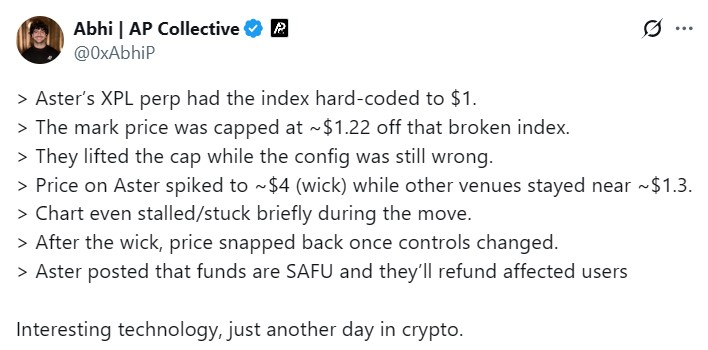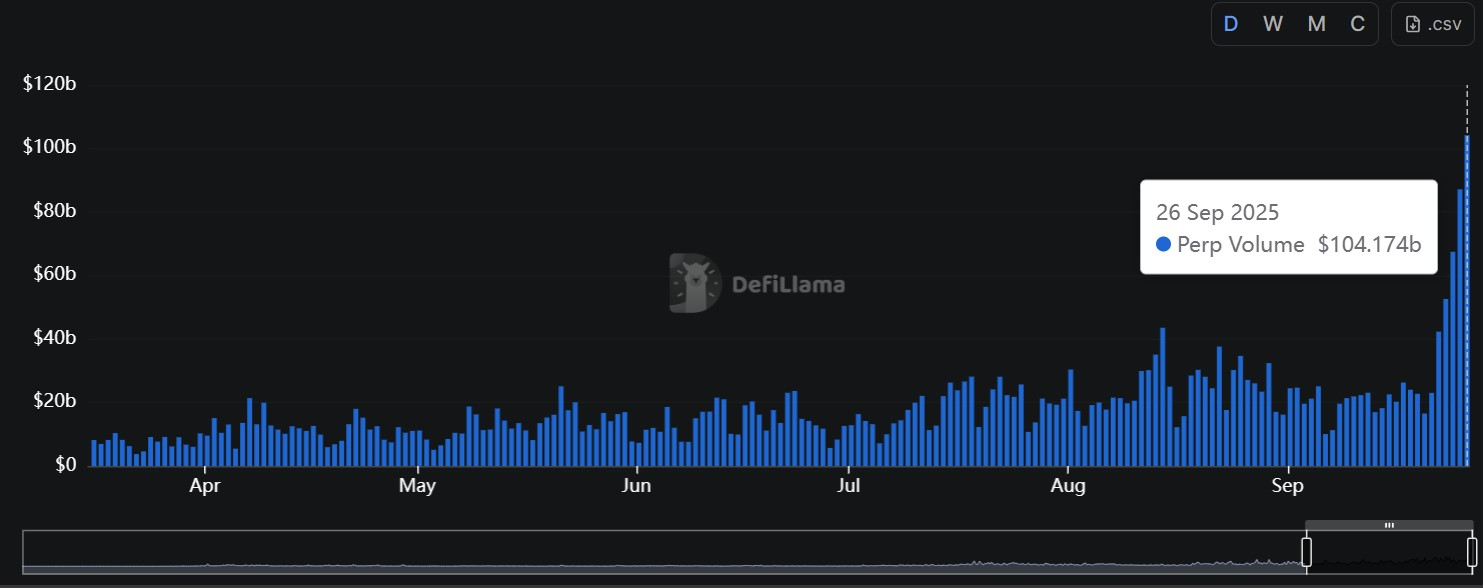Aster reimbursed traders after an Aster XPL glitch briefly drove XPL perpetual prices far above market levels, triggering liquidations. The DEX confirmed all reimbursements and extra fee compensation were distributed while reporting record daily perpetual volume of $104 billion.
-
Aster reimbursed all affected traders after an XPL mark-price misconfiguration caused abnormal liquidations.
-
Reimbursements included principal losses, trading fees and liquidation fees, and were fully distributed within hours.
-
Despite the incident, Aster’s perpetual DEX volumes surged to a record $104 billion in a single day; DefiLlama and CoinGlass reported large market-share gains.
Meta description: Aster XPL glitch reimbursement: Aster repaid traders after an XPL futures spike; learn how reimbursements were handled and why the perpetual DEX hit $104B daily volume. Read next steps.
What caused the Aster XPL glitch and how were traders reimbursed?
The Aster XPL glitch was caused by a misconfigured index price hard-coded at $1, which was briefly uncapped and caused XPL mark prices to spike above market levels. Aster confirmed all affected traders were reimbursed and additional fee compensation was issued within hours.
How did the misconfiguration trigger liquidations?
The index hard-coded at $1 was lifted before corrective measures, so Aster’s XPL perpetual mark price spiked toward $4 while other venues quoted around $1.3. This large price divergence produced unexpected liquidations and abnormal fee accruals for users who held leveraged positions.

Why did Aster move quickly to reimburse users?
Aster prioritized custody and market integrity, stating all funds were safe and pledging full compensation for losses. The team reimbursed users for realized losses as well as trading and liquidation fees to restore user balances and trust.
Who identified the issue and what exactly was fixed?
Industry observers and Web3 practitioners — including Abhishek Pawa, CEO of AP Collective — reported the issue originated in a misconfigured index value. Aster reverted the index cap and patched the configuration, then ran accounting routines to calculate and distribute reimbursements.
How big was the trading volume surge on Aster’s perpetual DEX?
On Friday, perpetual DEXs reported an aggregate daily volume of $104 billion, driven largely by Aster’s surge. DefiLlama data showed Aster accounted for approximately $46 billion of that daily volume, eclipsing competitors such as Lighter and Hyperliquid.
DefiLlama recorded Aster’s single-day volume at $46 billion, while Lighter and Hyperliquid registered near $19 billion and $17 billion respectively. CoinGlass indicated Aster’s open interest reached roughly $1.15 billion at the time of reporting.

What is the XPL token?
XPL is the native token of Plasma, a layer-1 chain designed for stablecoins with zero-fee Tether (USDT) transfers and EVM compatibility. The project has notable backers in the tech and crypto ecosystem and has been rapidly adopted by DeFi applications.
What recent on-chain demand signals show for Plasma and XPL?
Ethena’s USDe markets on Aave via Plasma reached initial supply caps of $1 billion within hours of launch, highlighting strong demand for synthetic dollar liquidity on Plasma. These on-chain metrics contributed to increased trading activity on Aster’s perpetual markets.
Frequently Asked Questions
How can affected traders verify they received reimbursements?
Traders should check their Aster account transaction history and balances for reimbursement entries and fee credits; Aster announced reimbursements were distributed and provided account-level reconciliation details to impacted users.
Is trading on high-volume DEXs like Aster risk-free?
No. High volume and rapid innovation increase both liquidity and operational risk. Users should manage leverage, monitor mark price mechanisms, and maintain risk controls to limit exposure to episodic market or protocol anomalies.
Key Takeaways
- Incident resolved: Aster identified a misconfigured index and fully reimbursed affected traders, including fee compensation.
- Volume surge: Aster’s activity helped push perpetual DEX daily volume to $104 billion, with Aster recording roughly $46 billion in one day.
- Operational risk: High-volume decentralized venues can still face configuration and oracle risks; strong user risk management is essential.
Conclusion
In summary, the Aster XPL glitch stemmed from an index misconfiguration that briefly inflated perpetual prices and caused liquidations. Aster moved quickly to reimburse all affected traders and cover fees while trading volumes reached record highs. Watch for follow-up protocol audits and account reconciliations as market participants assess longer-term implications.
Aster reimbursed traders after an XPL glitch caused liquidations, as its perpetual DEX drove daily trading volumes to a record of more than $100 billion.
BNB Chain derivatives decentralized exchange (DEX) Aster completed reimbursements to traders affected by a glitch in its Plasma (XPL) perpetual market that briefly drove prices above market levels.
According to Abhishek Pawa, the CEO of Web3 agency AP Collective, the issue stemmed from a misconfigured index hard-coded at $1. With the mark price cap lifted before the fix, XPL futures on Aster spiked to nearly $4 while other venues remained $1.3.
The sudden price discrepancy triggered unexpected liquidations and abnormal fee charges, causing losses to users. However, the platform quickly moved on Friday, assuring its users that all funds were safe and promising to compensate them for any losses.
Just hours later, the DEX said the reimbursements for the incident had been fully distributed to their accounts. Shortly after, Aster deployed another round of compensation, including trading and liquidation fees.
Aster has sustained its rapid growth this week, driving overall perpetual DEX volumes to $104 billion on Friday — marking the fourth straight day of record daily highs.
DefiLlama showed that Aster recorded $46 billion in volume on Friday, dwarfing its competitors Lighter and Hyperliquid, which both had strong performances of nearly $19 billion and $17 billion, respectively.
Aster’s volume surge started on Wednesday, surpassing its strongest competitor, Hyperliquid, with a trading volume of nearly $25 billion. At the time of writing, CoinGlass showed that Aster’s open interest was at $1.15 billion.
While Aster’s metrics kept going up, community members voiced concerns over potential risks for traders.
One community member expressed skepticism over the trading volume on Aster, bringing up airdrop incentives for using the platform. Another user urged traders to cash out on their trades, saying that it’s easy to lose money at this stage.
What is the XPL token?
XPL is the native token of Plasma, a layer-1 network optimized for stablecoins. The network offers zero-fee Tether (USDT) transfers and EVM compatibility for smart contracts and is backed by venture capitalist Peter Thiel and Tether CEO Paolo Ardoino.
The network has recently gained traction within the DeFi ecosystem. On Friday, Ethena’s USDe lending markets on Aave via Plasma reached their initial $1 billion supply caps within hours of launching, signaling strong demand for the synthetic dollar stablecoin on Plasma.
Magazine: ‘Help! My robot vac is stealing my Bitcoin’: When smart devices attack
